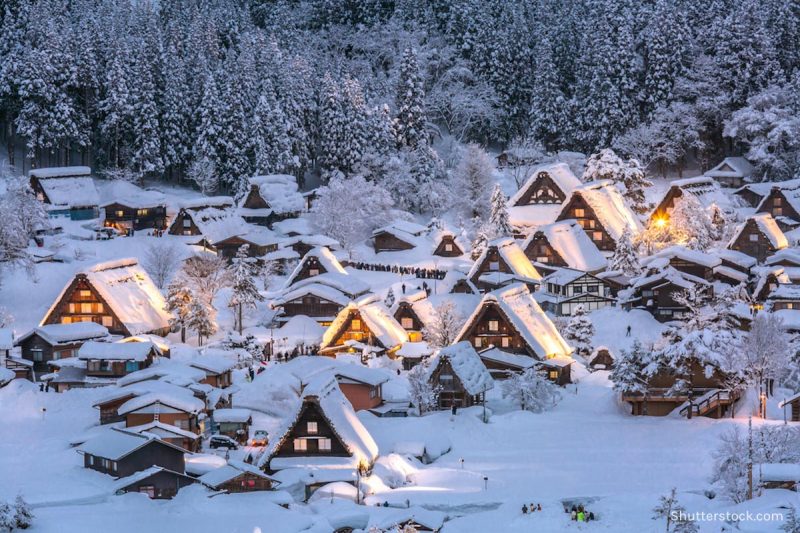Christabel Sasabone spent a week in Chubu, Japan and showcases some unique destinations for the adventurous and curious traveller who wants to indulge in some of the best scenic views of central Japan.
Planning a trip to Japan? Chubu may not be on the top of your list of cities to visit, but the capital city of Aichi Prefecture is somewhat of a well-kept secret. As the fourth largest city after Tokyo, Yokohama and Osaka; Nagoya plays an essential part in the cultural and historical identity of Japan. It is also where the samurai and ninja culture evolved. Below are some recommendations for places to visit while you are there, including the infamous Villages of Shirakawa-g0, a designated UNESCO World Heritage Site.
Hachiman Kamado (Ama Hut Experience)
Address: 517-0032 Mie Prefecture, Toba, 819
Hours: 10:00am – 4:30pm
Phone: +81 599-33-1023
There are about 1,000 professional female shellfish divers called “ama” in the Ise-Shima region. They are known as the vigorous working women of Ise-Shima. Traditionally, they dive into the sea without SCUBA equipment like oxygen tanks to catch shellfish and harvest seaweed.
Their fishing method has a long history and can be traced back to ancient records. It is a unique part of the Japanese culture in this region. While working in the sea, they breathe in a unique way to avoid damage to their lungs. Their breathing method is called isobue (sea whistle).
Ama Hut is an actual hut where ama divers take refuge and congregate with their fellow divers after going in the ocean. Visitors can enjoy the fine flavours of fresh, local, chargrilled seafood while listening to the stories told by the cheerful ama divers in their traditional white diving suits.
Trying on their traditional outfits and learning their dance was the highlight of the trip for me. The amas were the some of the most friendly people I met in Japan, and although I was unable to talk with them one-on-one due to language barriers, we were still able to communicate through movement when they were teaching their beautiful dance steps.
Okage-yokocho Street
Okage-yokocho Street by Christabel Sasabone
Address: 52 Ujinakanokiri Tow, Ise, Mie Prefecture 516-8558
Hours: 9:30am – 5:00pm
Phone: +81 596-23-8838
This is the street to visit if you’re looking for traditional Japanese snacks. At Fukusuke restaurant, you can try ise udon, which is an extra thick udon noodle that takes up to an hour to cook. Or, you can try the Japanese red bean mochi called akafuku at Akafuku Honten restaurant. There is also premium sake on offer at the Iseman Naiku Mae Japanese Sake Factory.
Apart from buying souvenirs, you can experience a lot of special Japanese events depending on the season. In Spring, you can eat sweet rice crackers and see koi nobori, which are carp-shaped kites traditionally flown in Japan to wish health and success to boys. In Summer, Tanabata festival decorations and furin (wind bells) are shown. In Autumn, you can try making hariko-manekineko, a special type of paper maché found only in Japan. In winter, you can make kadomatsu (Japanese New Year’s decorations) and ehomaki, a type of giant sushi roll with seven different ingredients typically eaten on Setsubun, a religious festival welcoming Spring.
Think of it as a street full of wonder and little knick-knacks. The deeper I went walking through the street, the harder it was for me to hold back the temptations of buying something randomly. I ended up buying a chocolate-flavoured ice cream cone from one of the stalls there because I wasn’t adventurous enough to try their other exciting flavours, such as miso soup, seaweed, or even soy sauce flavoured ice cream. A must-try though, if you’re curious and adventurous enough.
Nabana no Sato (Winter Illumination)
Nabana no Sato by Christabel Sasabone
Address: 511-1144 Mie Prefecture, Kuwana, 270
Hours: 9:00am – 9:00pm
Phone: +81 594-41-0787
With millions of LED lights illuminating this flower park, Nabana no Sato is considered one of the largest illumination events in the country. The attractions visitors can enjoy in this park include two light tunnels, a huge field transformed into a sea of lights with an animated light show as well as an observation deck which visitors can get a bird’s eye view of the park and its displays.
Nabana no Sato is also known for its seasonal flowers throughout the whole year other than the Winter Illumination, as there is a Floral Festival in the spring. From spring to summer, the park is home to a variety of flowers namely daffodils, roses, tulips and hydrangeas.
Out of all the places I’ve visited in Japan, this was the most “Insta-genic” place. One post on Instagram had all of my followers asking about this park. Nabana no Sato is perfect for those who loves taking amazing pictures as I’d say this place reminds me of a grander and bigger Gardens by the Bay in Singapore.
Yoro Park: The Site Of Reversible Destiny
Yoro Park by Christabel Sasabone
Address: 503 1267, 1298-2 Takabayashi, Yoro, Yoro District, Gifu Prefecture
Hours: 9:00am – 5:00pm
Phone: +81 584-32-0501
Yoro Park, opened to the public in 1995, is a landscape containing disorienting spaces and shifting colours all throughout the park. It is truly an experience in the Gifu Prefecture.
The theme of the park is to “encounter the unexpected” and was constructed over 30 years by world-renowned artists, Shusaku Arakawa and Madeline Ginz. The park itself is made up of two distinct areas: The Destiny House and the Elliptical Field. Throughout the park, you can find steep hills as well as strange works of art (like the slope populated with furniture that is hard to climb and also hard to use once you get there) that provide a truly unique and oftentimes discombobulating experience for all involved.
Unfortunately, I wasn’t able to explore all of the areas of the park but was still able to enjoy the beautiful landscapes with all of the colourful trees during Winter.
Hamonoya Sanshu Knife Shop
Hamonoya Sanshu Knife Shop by Christabel Sasabone
Address: 950-1 Oze, Seki-city, Gifu, 501-3265
Hours: 8:30am – 5:30pm
Phone: +81-575-28-5147
Sanshu knives are a product of 800 years of forging traditions, handcrafted by the blacksmiths from Seki, Japan. Seki, a historical city in Japan known for its blacksmith techniques, is where the country’s legendary samurai swords were first made. To this day, the same techniques are still being used to create the best blades in the country.
The Sanshu Knife Market is run by a third-generation owner, and his craftsmen create the blades in the traditional Seki way. The owner commissions a group of local blacksmiths to forge them. After the blacksmiths hand over the finished blades, the company’s own craftsmen then fit custom handles to each blade and hone them once more. After that, they are ready for sale.
Sadly, Customs don’t allow katana swords into Indonesia. Trust me, I’ve enquired with both the owner of the shop and my tour guide. I did, however, manage to buy a nail clipper from the shop and was still advised to put it in checked baggage. I’d say that’s close enough.
Mino City
Mino City by Christabel Sasabone
Address: Mino, Gifu Prefecture, Chubu
Be prepared to be transported back to the Edo Period of Japan when you visit Mino City. Mino has earned a place in history as the centre of Japanese paper production (mino-washi) for over a 1,000 years.
One of the most popular tourist sites within the prefecture is the city houses. The houses on the streets are lined with what they call udatsu or roofed dividing walls and is famous for housing washi wholesalers. To this day, the buildings of the city are preserved as cafés, town archives and sake brewers. Be sure to drop in by the Mino-Washi Museum, which showcases unique washi designs from all around the country.
I visited the town on a Tuesday, which was the day when all of the shops were closed. I was still able to enter the museum for a quick visit but was unable to visit the shops to see how the washi are made. It wasn’t all bad since the town was so quiet and empty, walking around there felt very peaceful and calm (plus, it was a perfect opportunity to take pictures without all of the other tourists!).
Shirakawa-go
Shirakawa-go by Christabel Sasabone
Address: Shirakawa, Ono District, Gifu Prefecture 501-5600
Phone: +81 5769-6-1311
This famous village was once considered a wild and unexplored region due to its location by the mountain. In 1995, it was declared a UNESCO World Heritage Site for its architecture and farmhouses called gassho-zukuri, some of which are more than 250 years old.
Gassho-zukuri translates to “constructed like hands in prayer” as the rooftops of the houses resemble the hands of Buddhist monks pressed together in prayer. The roofs are made without nails and have developed over generations. They were purposely designed to withstand the heavy snow that falls in the region during winter.
Although this place is quite scenic and gorgeous, it is popular with tourists and often quite crowded. Also, the village is famous for handmade dolls called the sarubobo (faceless dolls). Each colour represents some kind of luck. The blue one is for work, yellow is for wealth, pink is for love, and the black one is to remove any bad luck. I bought two pink sarubobo just in case, haha.
Inuyama Castle
Address: Kitakoken-65-2 Inuyama, Aichi Prefecture 484-0082
Hours: 9:00am – 4:30pm
Phone: +81 568-61-1711
Initially constructed in 1537, Inuyama Castle is one of five castles in Japan declared a national treasure by the government and its people. Despite being the smallest out of the other four castles, it is also one of the oldest. Inuyama is one of a dozen castles that have survived and stayed intact after numerous natural disasters and wars.
The castle’s main structure is built almost entirely of wood and rocks and retains an authentic feel without modern additions that reconstructed castles sometimes include such as elevators. The steep stairs, one of the conserved features of the castle, is four stories high. Visitors are able to climb up to the top level to enjoy the gorgeous views over the castle grounds as well as the Kiso River, which the castle’s small hill stands next to. Visitors can also view through a lookout, which was used to watch over approaching enemies.
After catching my breath when I reached the top of the castle, I went outside to the castle’s balcony and enjoyed the view. Ignoring my fear of heights for a quick photo here and there was definitely worth it.




